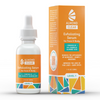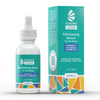10 Steps to Clear Body Breakouts
1. Apply a leave-on acne product daily (and no spot treating!).
The most important thing you can do to clear your skin is to consistently apply a treatment product to the entire area where you break out. Leave on products include serums, creams, sprays, and medicated pads. These products are crucial because they have time to absorb into the skin and dissolve clogged material in the pores. Make sure to apply the product to the entire area where your skin breaks outs, not just to active blemishes. When you apply a treatment product every day to the whole problem area of skin, you prevent new blemishes from forming. Eventually, you’ll be blemish-free. In contrast, spot-treating existing blemishes is like playing a game of whack-a-mole. You may be able to zap a few zits this way, but you’ll always be battling new breakouts.
2. Shower as soon as possible after exercising.
After working out do you wear your sweaty gym clothes to run errands? Stop doing that!! Sweaty clothes greatly exacerbate clogged pores and folliculitis. It is very important to change into clean clothes as soon as possible after exercising. Even if you can’t shower right away, do a quick cleanup in the gym with some wet paper towels and soap and then change into fresh clothes. Your skin will thank you for it!
3. Use a gentle cleanser.
Washing your skin removes dirt, oil, makeup, bacteria, and other pollutants that can clog pores. Make sure to use a gentle cleanser because leave-on acne treatment products can be drying. Further drying and irritating the skin with a harsh cleanser does nothing to clear the skin and can even be counterproductive, so look for a wash that’s gentle and non-irritating.
4. Don’t scrub too hard.
Exfoliating the skin is important for stopping pimples, but the best way to do this is with a leave-on acne treatment product that acts as a chemical exfoliant (see tip #1). Exfoliating products bust apart oil and dead skin cells, allowing for this grime to exit the pores and be washed away from the surface of the skin. Physically exfoliating the skin (ie harsh scrubbing of the skin with a loofah, brush, or abrasive scrub) is bad news for zits. When you scrub too hard, you inflame blemishes, cause them to get redder and more irritated, and spread breakout-causing bacteria between the pores. Instead, use a soft washcloth and scrub softly in circular motions, and never use abrasive scrubs on acne-prone skin. Aaahhh, much better!
5. Wear breathable clothing and underwear.
Cotton is the best choice. Bacteria that cause bad flare-ups thrive in anaerobic conditions, so give your skin some oxygen! If you have bumps on your butt, then wearing cotton underwear is critical.
6. Change out of tight-fitting clothes when possible.
When you’re home for the day, change out of tight-fitting clothes like skinny jeans, spandex, lycra, or tight workout attire and put on loose-fitting clothing. This allows your skin to breath. Also, tight clothes can rub against body bumps and further aggravate the problem, so wearing loose, soft clothing when possible is a must.
7. Use the right kind of sunscreen.
Find a high-quality sunscreen that is non-comedogenic (non-pore clogging). These sunscreens often say “for the face,” but go ahead and use them on your body, too.
8. Manage your stress.
People with acne-prone skin are prone to getting new pimples during times of stress. This happens because stress activates the adrenal glands, causing them to produce extra stress hormones. An elevation in hormones will cause the skin to breakout. Stress also slows down the healing process and causes the immune system to get out of whack, which will delay the healing of existing blemishes. To better deal with stress, adopt a meditation and breathing practice and/or get regular exercise. Less stress will lead to clearer skin and a happier, more balanced life.
9. You are what you eat (and drink!).
Your skin is impacted by your dietary choices. Make sure to drink enough water and eat a balanced, healthy diet. Many people have noticed a link between a diet high in simple carbohydrates and refined foods and acne and folliculitis breakouts. Some people also notice that consuming dairy products increases breakouts. Pay attention to how your diet affects your skin.
10. Don’t pick at your skin.
When you squeeze a blemish in order to pop it, you run the risk of rupturing the inflamed pore. When pore walls rupture, bacteria and pus are spread into the surrounding tissue and skin, resulting in more inflammation and a red, angry-looking pimple. Using a leave-on treatment product (see tip #1) will help pores to get unplugged without picking at them. The only time it’s okay to extract a pimple is if pus is clearly visible near the surface of the skin. Only then can you pierce the blemish with a clean needle and then squeeze it softly with clean hands. If the pimple doesn’t expel its contents after a couple of gentle squeezes then stop trying- it’s not ready yet.


